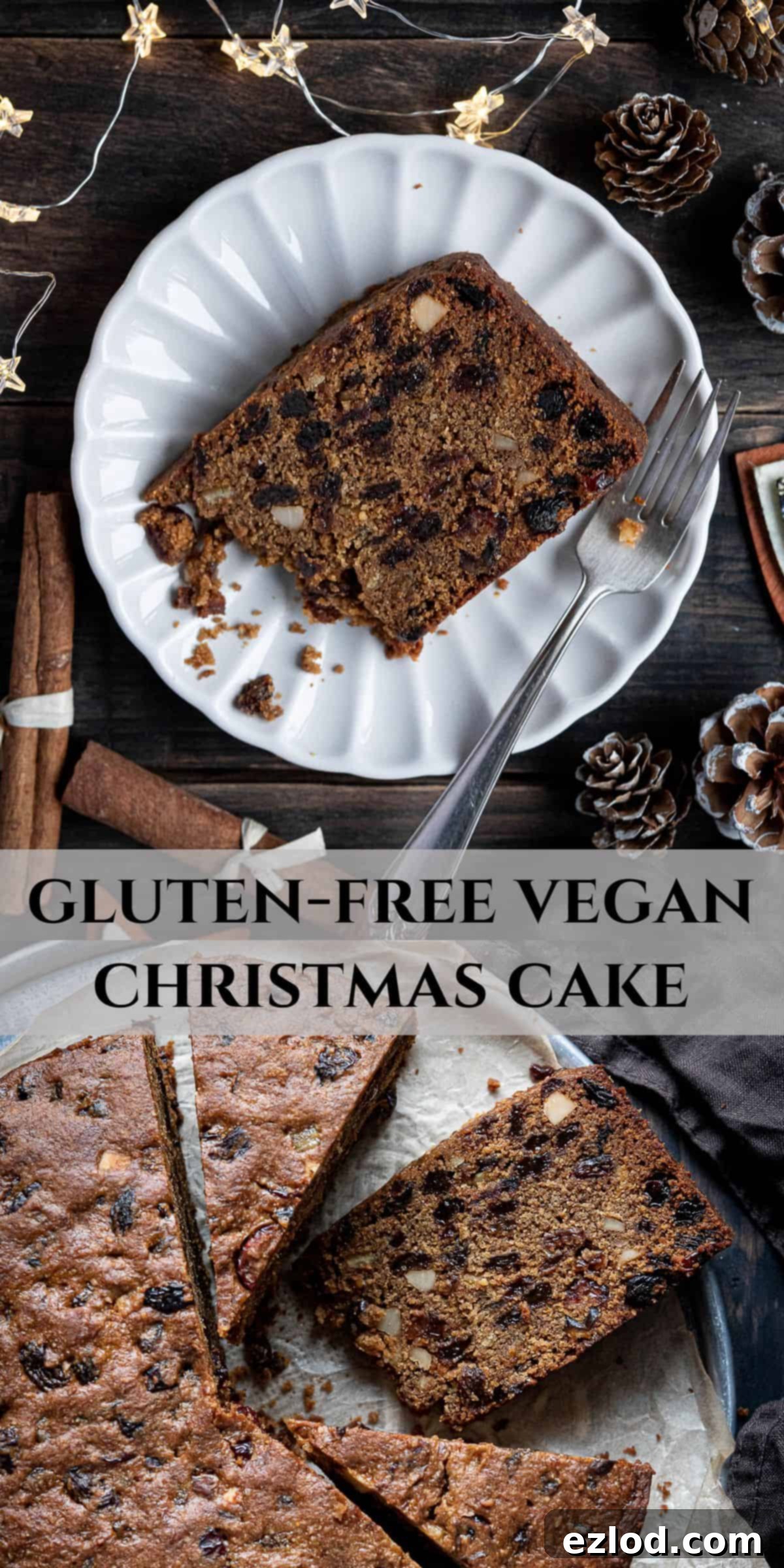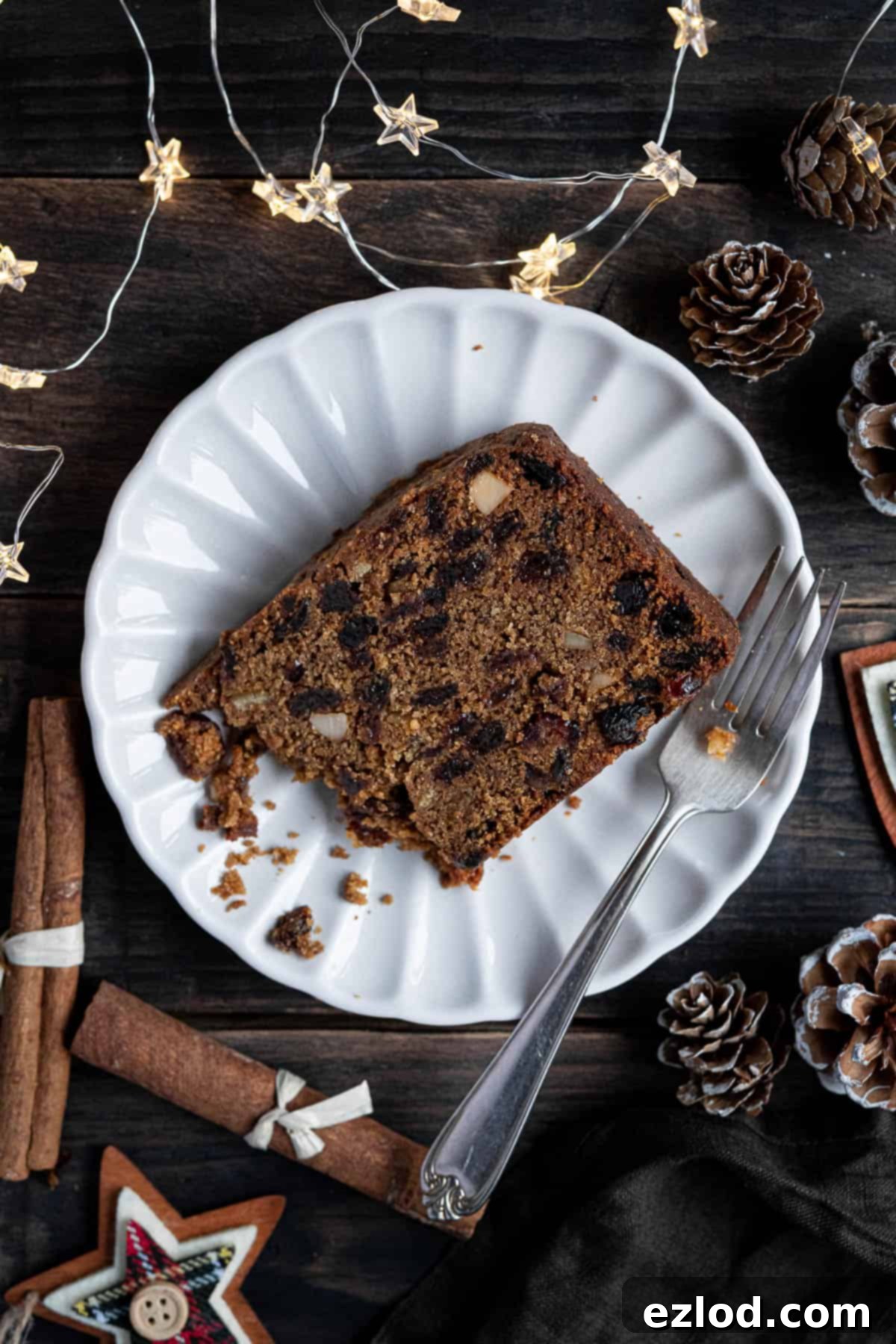Ultimate Gluten-Free Vegan Christmas Cake: Moist, Rich & Festive!
Celebrate the holidays with this incredible Gluten-Free Vegan Christmas Cake! This recipe is specifically designed to be free from eggs, dairy, and gluten, ensuring that everyone can indulge in a slice of festive deliciousness.
Crafted for ease, this cake boasts a perfectly moist, wonderfully rich, and utterly delicious flavor profile. It’s versatile enough to be enjoyed immediately or prepared in advance and matured, allowing its complex flavors to deepen over time.
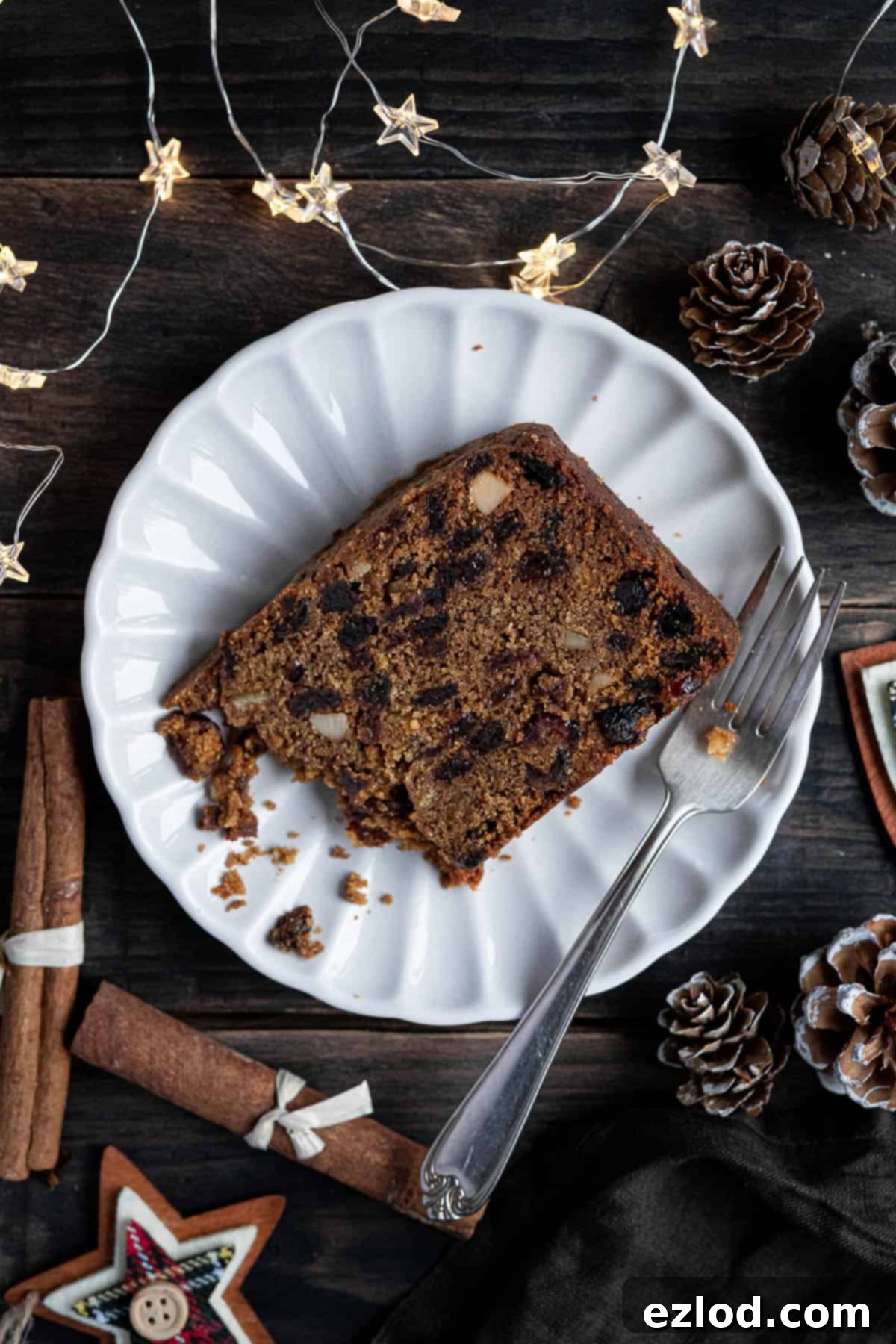
For years, I’ve received countless requests about adapting my popular vegan Christmas cake recipe to be gluten-free. While the desire for an inclusive festive treat is strong, simply swapping flours in an existing recipe often leads to disappointing results. My original vegan fruit cake, for instance, when made gluten-free, unfortunately, resembled a sandcastle more than a cake, tending to disintegrate rather than slice neatly.
The truth is, creating a fruit cake that is both egg-free and gluten-free presents a unique challenge. Traditional fruit cakes already have a tendency to be a bit crumbly, and removing two key binding ingredients like eggs and gluten can easily result in a dry, sandy mess. Achieving that perfect balance of moisture, richness, and structural integrity requires a thoughtful approach and some clever ingredient substitutions.
After extensive testing and a journey of culinary experimentation, I’m thrilled to share a version that truly works – a truly remarkable gluten-free and vegan Christmas cake. This recipe delivers a cake that is exceptionally moist, incredibly rich, and bursting with all the comforting, traditional flavors of Christmas. It stands shoulder-to-shoulder with any regular fruit cake in terms of taste and texture, and best of all, it’s surprisingly simple to prepare.
Whether you choose to serve it fresh from the oven or prefer to make it in advance and “feed” it with your favorite spirits every week or two, this cake promises an exquisite experience. The maturation process not only enhances its richness but also deepens the festive flavors, making it an even more spectacular centerpiece for your holiday celebrations.
What Essential Ingredients Do I Need to Bake This Gluten-Free Vegan Christmas Cake?
Crafting a cake that is both vegan and gluten-free requires a careful selection of ingredients, each playing a crucial role in achieving the desired texture and flavor. Here’s a detailed look at what you’ll need and why these specific components are essential:
Gluten-Free Flour or Oat Flour: This recipe has been rigorously tested with two types of flour, both yielding excellent results. You can use a high-quality plain gluten-free flour blend (such as Doves Farm Freee), which typically contains a mix of rice, potato, tapioca, maize, and buckwheat flours. Alternatively, you can opt for homemade oat flour. Both options contribute to the cake’s structure without the need for traditional wheat gluten. (The beautiful cake featured in the photos was made using oat flour.) Directions for making your own oat flour are provided further down.
Silken Tofu: A game-changer for moisture and binding in vegan baking. Silken tofu is softer and has a higher water content than regular tofu, making it an ideal egg substitute that contributes to the cake’s lovely, tender crumb. It’s typically found in shelf-stable packaging rather than the refrigerated section. Brands like Mori-Nu or Clearspring are excellent choices. I haven’t tested substitutes for the silken tofu, but while vegan yogurt might seem plausible, I cannot guarantee the same results, so any such substitution would be at your own discretion.
Gram Flour: Also known as besan or chickpea flour, this ingredient is derived from ground chickpeas or a blend of chickpeas and yellow split peas. It’s naturally gluten-free and rich in protein, making it an exceptional binder and a fantastic vegan egg alternative in this specific recipe. Due to its unique properties, there is no direct substitute for gram flour in this formulation.
Ground Almonds: These finely ground almonds, often labeled as almond flour in the US, add a wonderful depth of flavor and contribute significantly to the cake’s moist texture and rich mouthfeel. I strongly advise against substituting ground almonds with more regular flour, as this would likely result in a much drier cake.
Xanthan Gum: An indispensable ingredient in most gluten-free baking, xanthan gum acts as a powerful binder and stabilizer. It mimics the elasticity and binding properties of gluten, helping to prevent the cake from crumbling and ensuring a cohesive texture. It cannot be omitted from this recipe.
Vegan Butter: For superior baking results, always opt for a solid vegan block butter, not the spreadable type. Spreads often have a higher water content, which can negatively impact the cake’s texture. Brands like Naturli Vegan Block or Flora Plant Butter are excellent choices for their baking performance.
Sugars: A combination of soft dark brown sugar and light brown soft/muscovado sugar is essential for both flavor and moisture. These sugars add a rich, caramel-like depth that granulated sugar cannot replicate. While you can use all dark or all light, be aware that this will alter the cake’s final color and flavor profile. Do not substitute brown sugars with other types of sugar, liquid sweeteners, or artificial sweeteners.
Treacle: Also known as molasses (especially in North America), treacle provides a distinctive robust, slightly bitter-sweet flavor and a deep color that is characteristic of traditional Christmas cakes. It’s a crucial component for the authentic taste.
Non-Dairy Milk: Any unsweetened non-dairy milk will work, but soy milk is often preferred in baking for its protein content, which can contribute to a slightly better structure and richness.
Bicarbonate of Soda (Baking Soda): This is a leavening agent that reacts with acidic ingredients to create lift. Do not confuse it with baking powder; they are not interchangeable, and using the wrong one will affect the cake’s rise and texture.
Vinegar: An acidic component (cider, white wine, or red wine vinegar work well) that activates the bicarbonate of soda, producing carbon dioxide and helping the cake to rise. If you need to avoid vinegar, lemon juice can be used as an effective substitute.
Spices: A warm blend of mixed spice, cinnamon, and nutmeg creates the quintessential festive aroma and flavor. In the US, apple pie spice can be used in place of mixed spice. Feel free to customize by adding extra spices like cloves, star anise, cardamom, or ginger for a more complex profile.
Orange and Lemon Zest: The finely grated zest of an orange and a lemon infuses the cake with bright, citrusy notes that perfectly complement the rich spices and dried fruits, adding layers of fresh flavor.
Dried Fruits: The recipe specifies a traditional mix, but the beauty of a fruit cake is its adaptability. As long as you maintain the total weight (660g), you can customize your fruit blend. Chopped dried apricots, figs, and dates are wonderful additions. For a more luxurious touch, consider dried cherries, blueberries, or even diced pineapple.
Alcohol: Rum is my go-to, but whisky, brandy, amaretto, or sherry are all excellent choices. You’ll need some to soak the dried fruits initially, allowing them to plump up and absorb the rich flavors, and additional alcohol for “feeding” the cake as it matures, enhancing its depth and moisture.
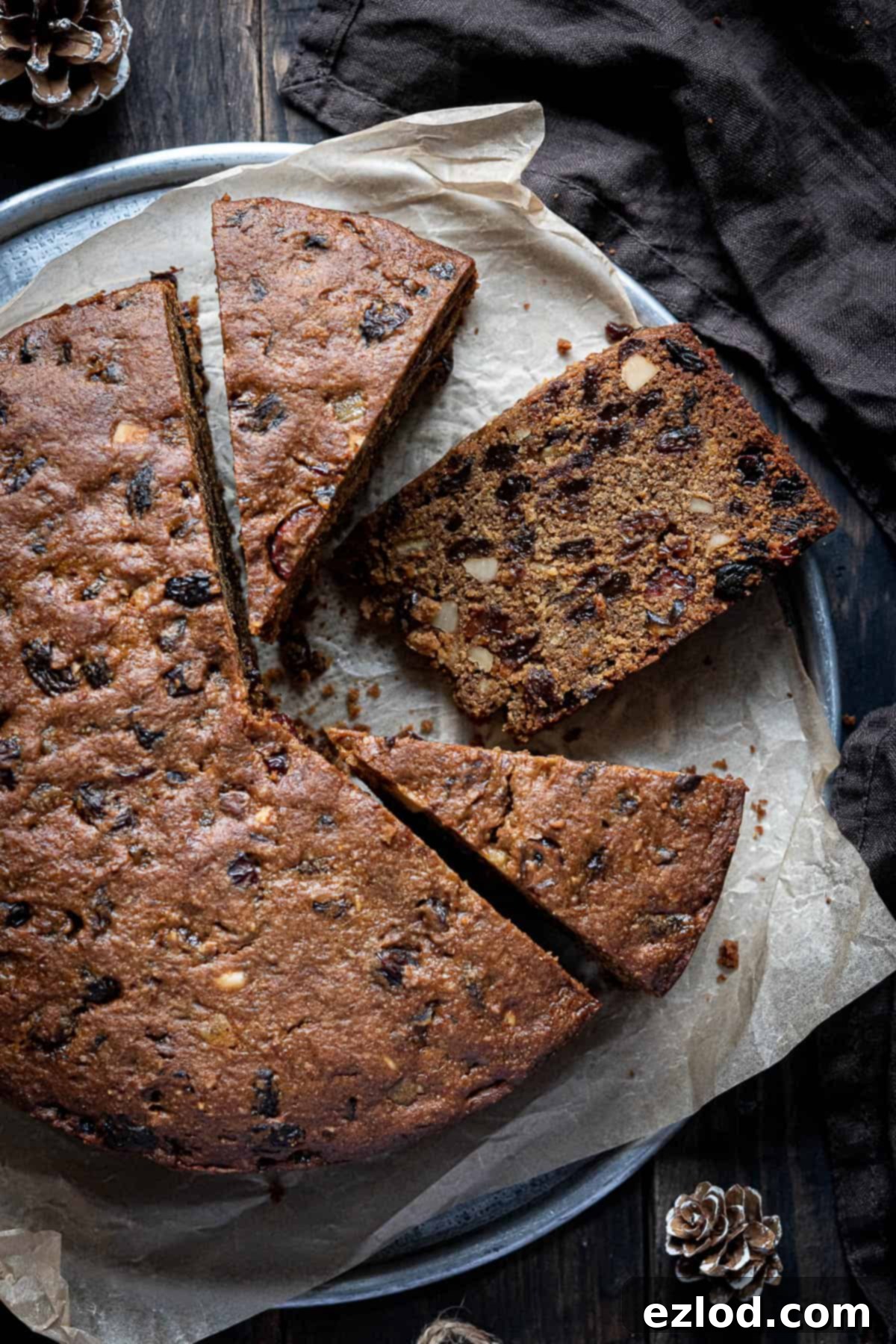
How To Master The Art of Making Gluten-Free Vegan Christmas Cake:
(For precise measurements and detailed instructions, please refer to the comprehensive recipe card located at the very bottom of this page.)
Prepare Your Fruits: Begin your Christmas cake journey the day before you plan to bake, or even up to a week in advance, by preparing the dried fruits. Combine all your chosen dried fruits with the alcohol in an airtight container. Give them a good stir periodically to ensure every piece is evenly coated and plumped up, absorbing all that wonderful flavor.
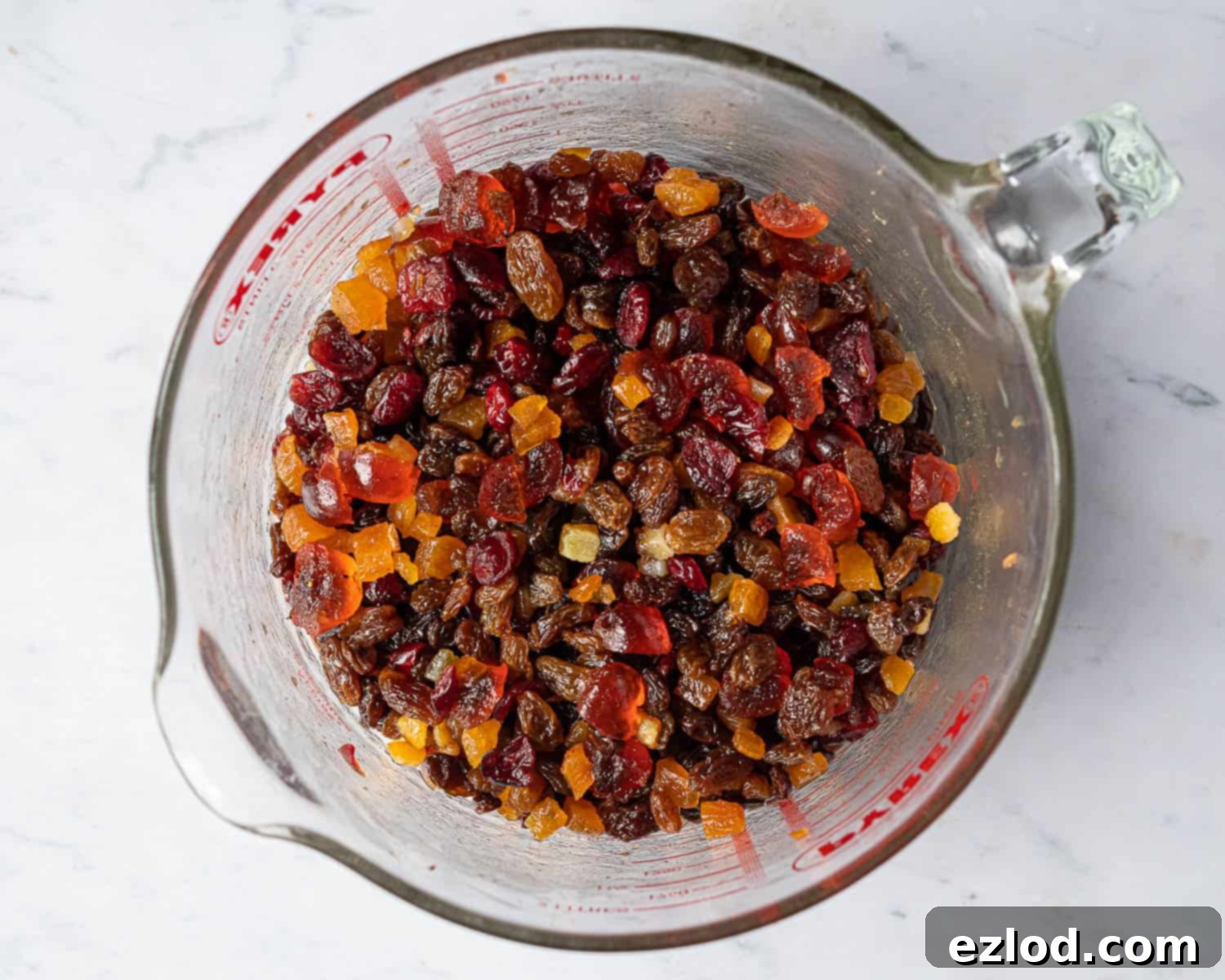
Blend the Liquid Components: The following day, prepare your liquid mixture. In either a blender or a jug with a stick blender (my personal preference), combine the silken tofu, non-dairy milk, and vinegar. Blend until the mixture is completely smooth and creamy, with no lumps remaining.
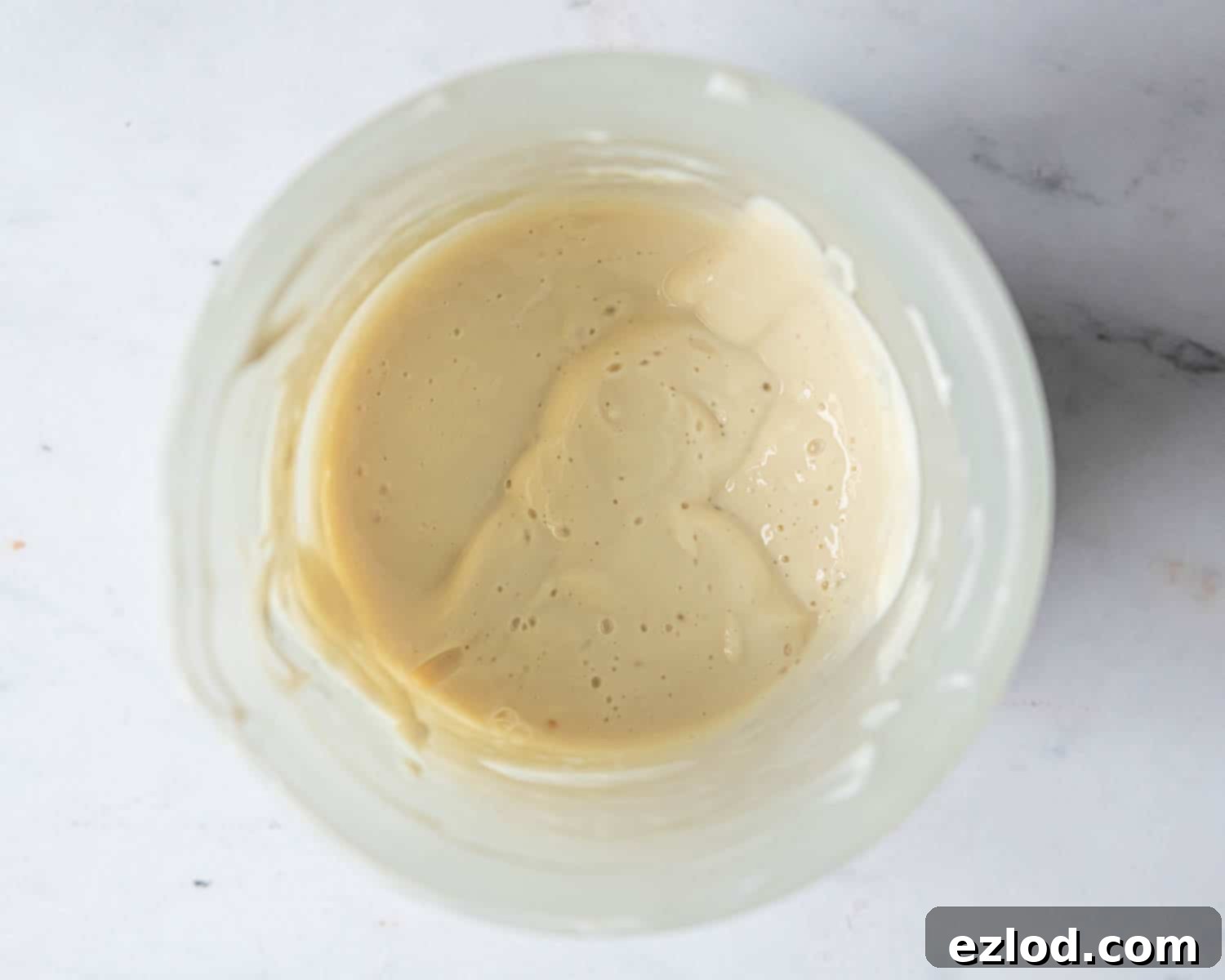
Cream Butter and Sugars: In a large mixing bowl, whisk together the softened vegan block butter, both dark and light brown sugars, treacle, and the finely grated orange and lemon zest. Continue whisking until the mixture becomes wonderfully light and fluffy, incorporating air for a tender crumb.
Add Dry Binders and Spices: To the fluffy butter mixture, whisk in the xanthan gum, bicarbonate of soda, mixed spice, cinnamon, nutmeg, and a pinch of salt. These ingredients are vital for both the cake’s structure and its signature festive flavor.
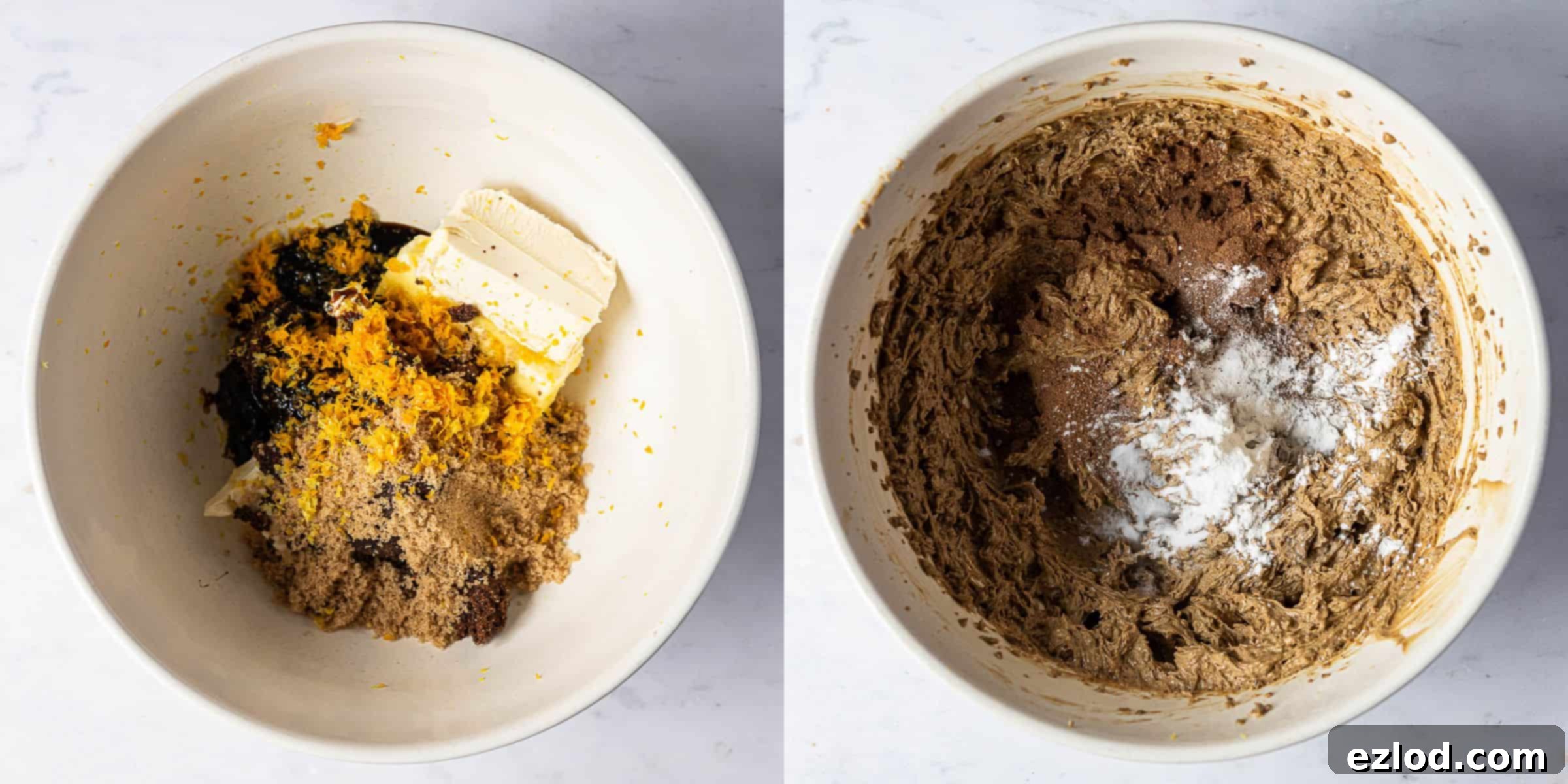
Combine Wet and Dry: Now, add the gluten-free flour (or oat flour), ground almonds, gram flour, and the previously blended tofu mixture to the bowl. Mix everything thoroughly until you achieve a smooth, thick, and consistent batter. Be careful not to overmix, which can toughen the cake.
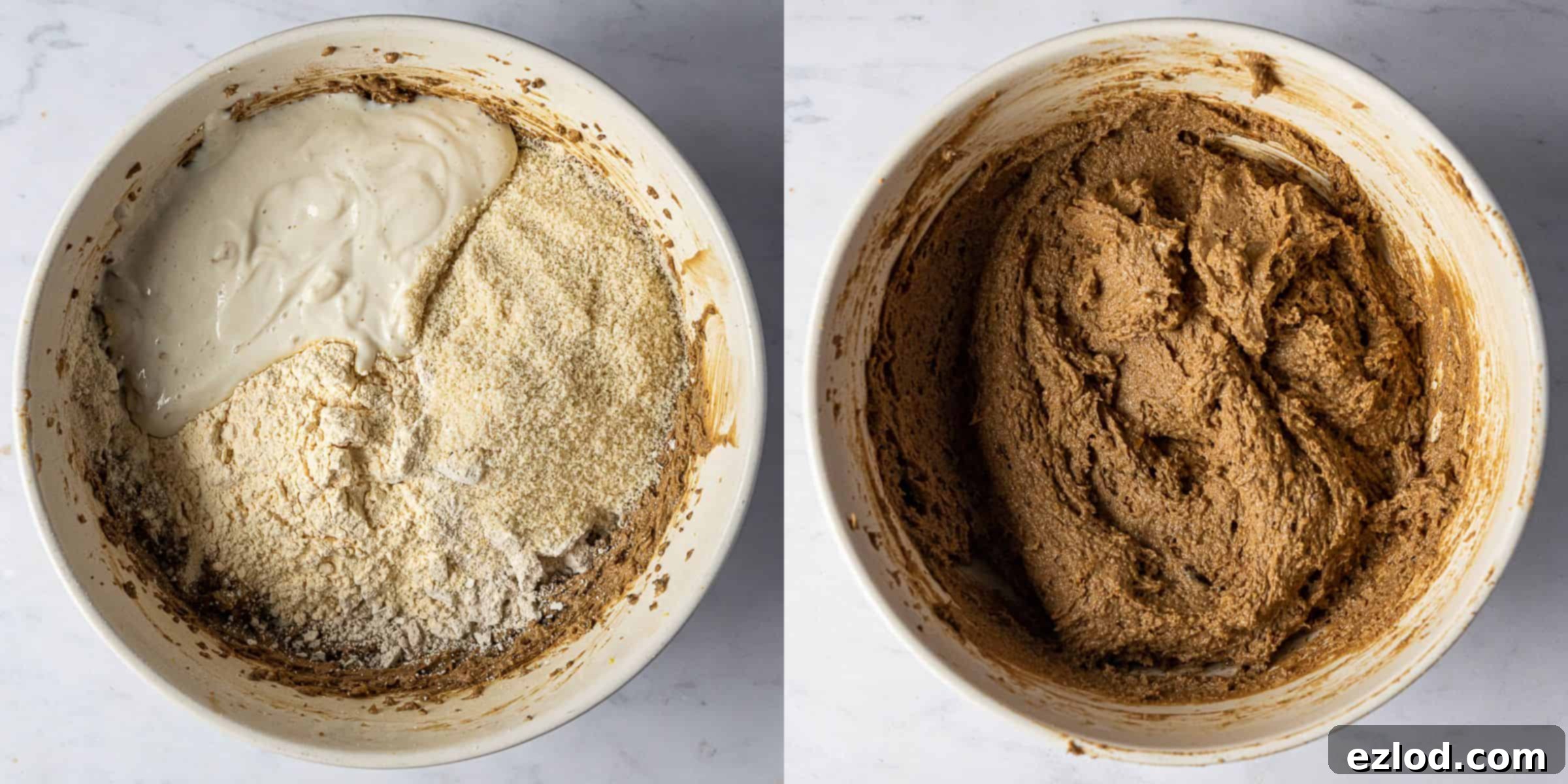
Fold in Fruits and Nuts: Gently fold the pre-soaked dried fruits, along with any remaining juices from their container, and the chopped blanched almonds into the batter. Ensure the fruits and nuts are evenly distributed throughout the mixture.
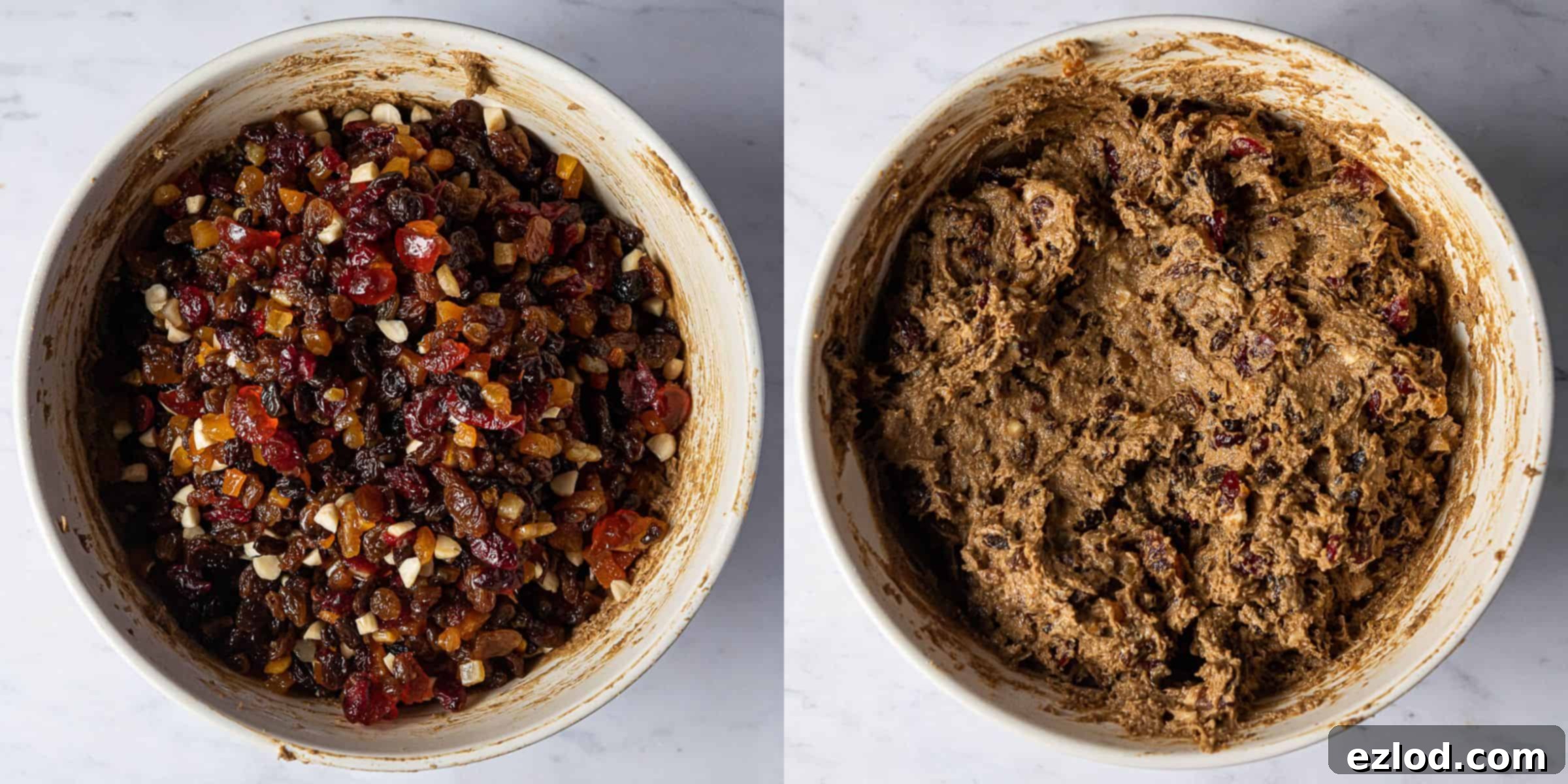
Prepare for Baking: Transfer the finished batter into your prepared cake tin. Spread it out evenly, then use the back of a wet spoon to smooth the top surface. Re-wet the spoon as needed to achieve a perfectly flat and smooth finish.
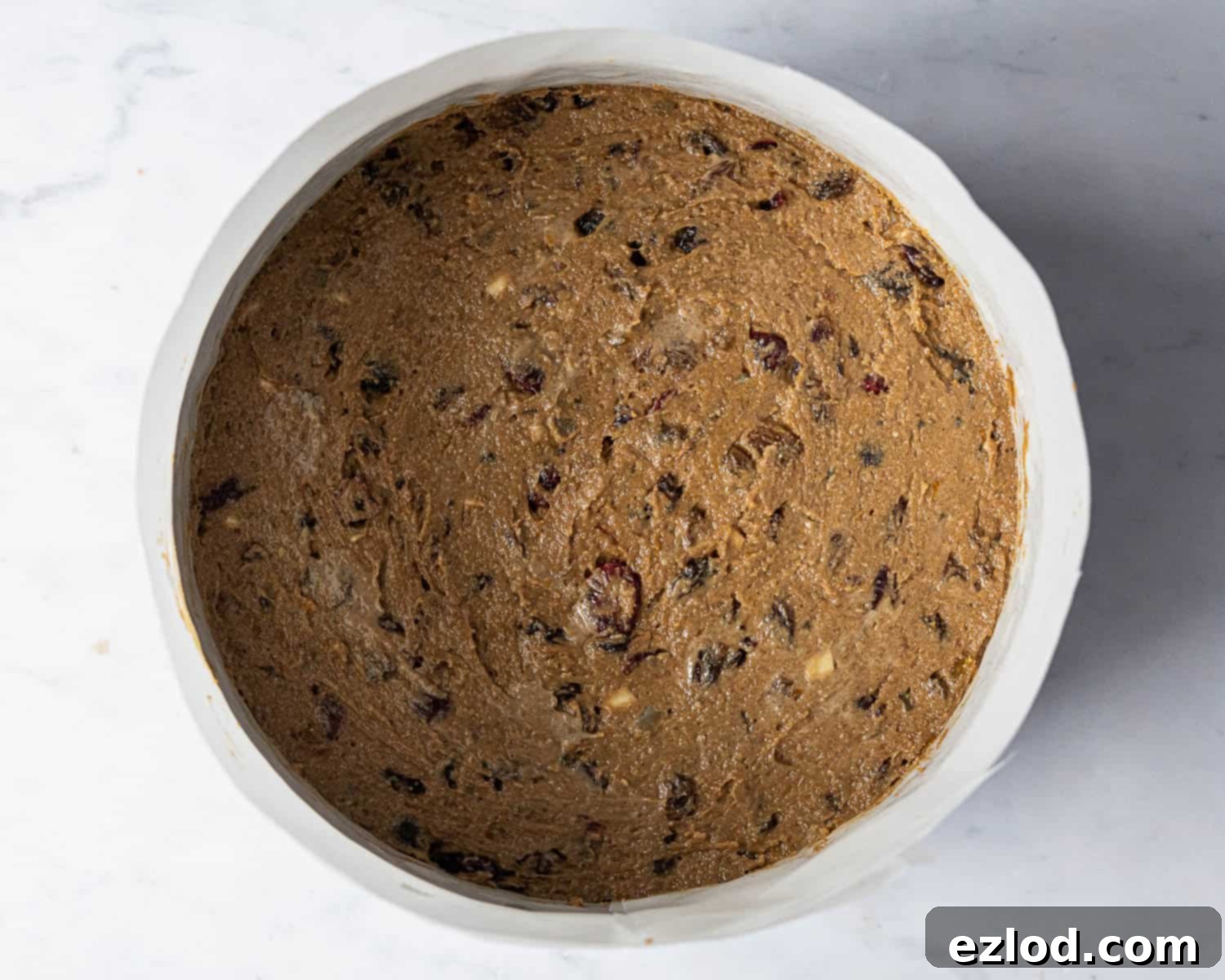
Bake to Perfection: Bake the cake for approximately 2 hours and 45 minutes. The cake is ready when a skewer inserted into its center comes out clean, or with just a few moist crumbs attached, but no wet batter. Keep an eye on the cake towards the end of baking; if the top starts to brown too quickly, you can loosely cover it with a piece of tin foil to prevent burning while the center finishes cooking.
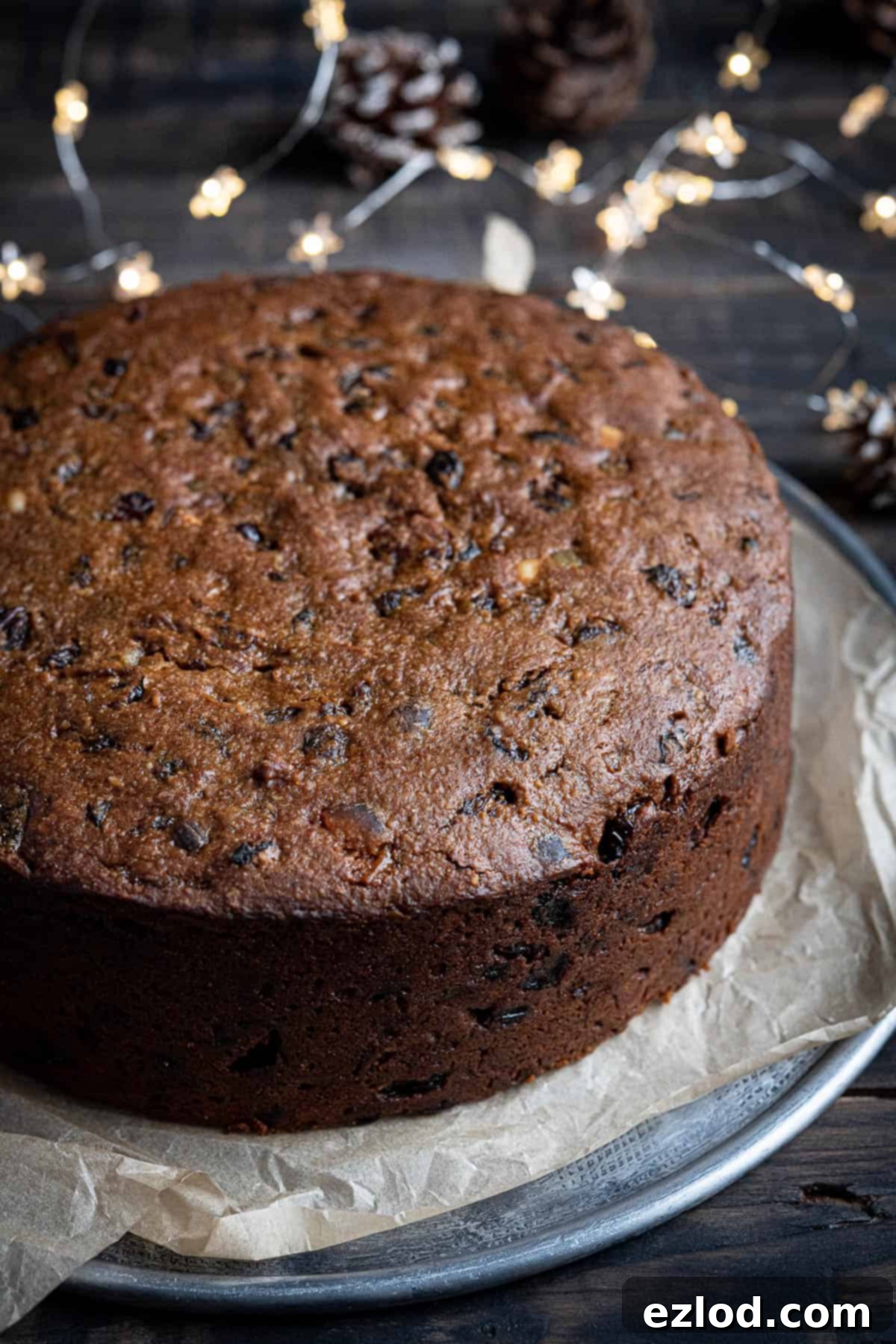
Top Tips for a Flawless Gluten-Free Vegan Christmas Cake:
Achieving the perfect Christmas cake, especially one that’s gluten-free and vegan, often comes down to attention to detail. Here are some invaluable tips to ensure your baking experience is a success and your cake is nothing short of magnificent:
- Precision is Key: Unlike some recipes, this cake is quite sensitive to ingredient ratios. For the most accurate and best results, please use a kitchen scale to measure all ingredients. I have intentionally not provided US cup conversions as they are often too inaccurate for the delicate balance required in this recipe.
- Follow the Recipe Exactly: For optimal results, adhere to the recipe as closely as possible. The ingredients have been carefully selected and balanced to work together harmoniously. Altering any ingredient, even slightly, could significantly impact the cake’s final texture and consistency. I cannot guarantee the outcome of any substitutions, so any changes are made at your own risk.
- Achieving Clean Slices: To get beautifully neat slices without crumbling, allow the cake to cool completely. Then, use a very sharp, serrated knife and employ a gentle sawing motion rather than pressing straight down. This technique helps to cut through the fruit and cake without tearing.
- Preventing Burnt Edges: To ensure the edges of your cake don’t overcook or burn before the center is perfectly baked, line your cake tin with a double layer of baking parchment. This creates an insulating barrier that promotes even baking.
- Testing for Doneness: The cake is perfectly cooked when it feels firm to the touch in the center. A skewer inserted into the very middle should come out clean, or at most, with a few moist crumbs clinging to it, but definitely no wet batter.
- Don’t Rush the Soaking: The instruction to soak the dried fruit at least overnight (and up to a week) is crucial. This step allows the fruits to plump up, soften, and absorb the alcohol, contributing to the cake’s incredible moisture and depth of flavor. Do not skip or shorten this step!
- Embrace the Process: While the ingredient list might appear long, don’t be intimidated! Each step is straightforward, and the overall process is manageable. The effort truly pays off with a stunning, flavorful Christmas cake.
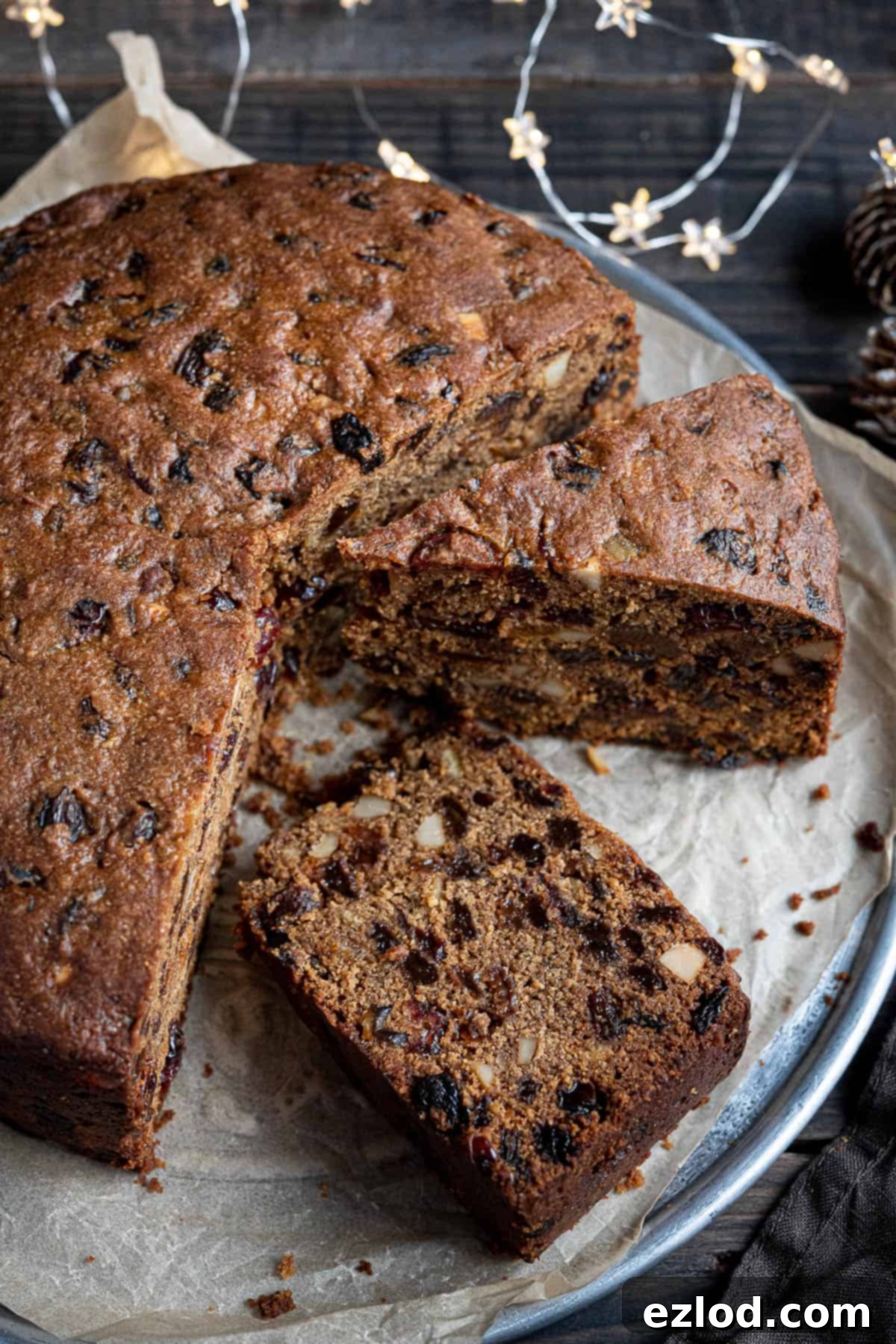
Is This Gluten-Free Vegan Christmas Cake Crumbly?
It’s a valid question, and let’s be realistic: fruit cakes, by their very nature, tend to be slightly crumbly, even traditional ones made with gluten and eggs. When you remove both of those binding agents, it’s natural to expect some degree of fragility. However, this specifically developed gluten-free and vegan recipe is engineered to provide the best possible texture.
While it does possess a delightful, tender crumb (as any good fruit cake should!), it is designed to slice cleanly without falling apart into a sandy mess. The carefully chosen ingredients, particularly the silken tofu, gram flour, and xanthan gum, work in harmony to provide sufficient structure and moisture. This means you can confidently cut beautiful slices and even decorate it with marzipan and icing without worrying about it disintegrating.
Can I Make This Christmas Cake Alcohol-Free?
Absolutely, you can certainly make an alcohol-free version of this delicious Christmas cake! To do so, simply substitute the alcohol used for soaking the fruits with an equal amount of good quality orange juice. The orange juice will still help to plump up the dried fruits and infuse them with a lovely citrus flavor, though it won’t offer the same depth or preservation benefits as alcohol.
It’s important to bear in mind, however, that if you choose not to “feed” the cake with alcohol during its storage, its shelf life will be considerably shorter. Alcohol acts as a natural preservative, helping the cake mature and last longer. If you’re making an alcohol-free cake, it’s best to bake it closer to when you intend to serve it, ideally within a week or two, to ensure maximum freshness and enjoyment.
How to Easily Make Your Own Oat Flour:
While certified gluten-free oat flour is readily available in most health food stores and larger supermarkets, it’s also incredibly simple and cost-effective to make your own at home. This ensures you have fresh flour and can be confident in its gluten-free status if you start with certified oats.
Here’s how to do it:
- Choose Your Oats: Start with certified gluten-free rolled oats. This is crucial to avoid cross-contamination if you have gluten sensitivities or celiac disease.
- Blend: Place the oats in a high-powered blender or food processor.
- Process Until Fine: Blend on high speed until the oats are transformed into a fine, powdery flour. You want to ensure there are no larger flecks or whole oat pieces remaining.
- Stir and Shake: You may need to pause your blender once or twice to stir the contents or give the blender jug a good shake. This helps to ensure that all the oats are evenly processed and no un-blended pieces are left at the bottom or sides.
- Time: Depending on the power of your blender, the entire process should take no more than 30 to 60 seconds. You’ll be left with perfectly fine oat flour, ready for baking!
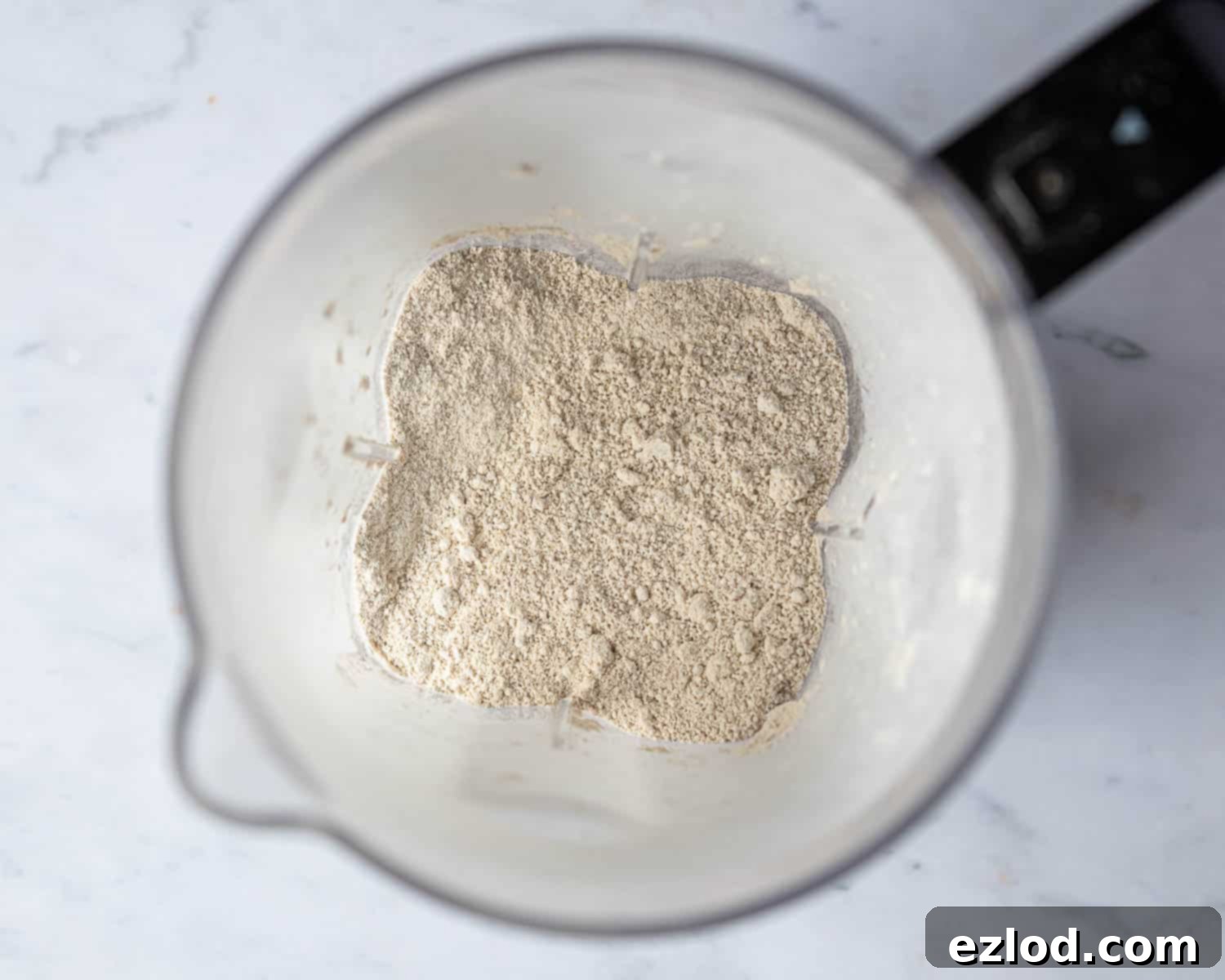
Proper Storage and Maturation of Your Christmas Cake:
One of the true joys of a Christmas cake is its ability to mature, deepening in flavor and becoming even more wonderfully rich over time. Proper storage is key to this process:
Cool Completely: After baking, ensure your cake has cooled down completely to room temperature. This can take several hours, often overnight. Rushing this step can lead to condensation and spoilage.
Initial Feeding: Once thoroughly cooled, carefully remove the cake from its tin. Using a pastry brush, generously brush the entire surface – top, bottom, and all sides – with your chosen alcohol (rum, brandy, whisky, etc.). This first “feed” helps to begin the maturation process and locks in moisture.
Wrap for Longevity: First, wrap the cake tightly in a double layer of baking parchment. This provides a breathable yet protective layer. Next, wrap it securely in a double layer of tin foil. This helps to prevent moisture loss and shields the cake from light and air. Finally, place the well-wrapped cake in an airtight container.
Storage Location: Store the container in a cool, dark place, such as a pantry or a cool cupboard. Avoid placing it in the refrigerator, as this can dry out the cake. When stored correctly, your cake can keep for up to a couple of months. (While some report success for up to three months, I generally recommend two months to be safe based on my testing.)
Regular Feeding (Maturation): To achieve that exceptionally rich and complex flavor, continue to “feed” the cake with a couple of tablespoons of alcohol every week or two. Alternate brushing the top and bottom surfaces of the cake each time to ensure even distribution. Continue this process until you are ready to decorate the cake. However, make sure to stop feeding the cake about a week before you plan to ice it. This allows the surface to dry out slightly, which is essential for the marzipan and icing to adhere properly.
How to Decorate Your Gluten-Free Vegan Christmas Cake:
Decorating a Christmas cake is a beloved tradition, adding that final festive flourish. Here’s how you can adorn your delicious gluten-free vegan creation:
Traditional Marzipan & Icing:
Traditionally, Christmas cakes are first enveloped in a layer of marzipan, followed by a layer of either royal icing or fondant. To ensure the marzipan adheres perfectly, warm some sieved apricot jam and brush it over the cake before applying the marzipan. Most commercially available marzipan and fondant are vegan-friendly, but always double-check the packaging to be sure.
For vegan royal icing, you can substitute the traditional egg white with aquafaba (the liquid from a can of chickpeas). It whips up beautifully to create a stable, pipeable icing.
Creative Toppings & Simple Elegance:
Once your gluten-free vegan Christmas cake is iced (or even if you choose to leave it plain!), the possibilities for decoration are endless. You can keep it elegantly simple, as I often do, by piling some gingerbread star biscuits of various sizes artfully on top. Other lovely ideas include:
- Frosted Fruits: Dust cranberries, rosemary sprigs, or small clementines with a touch of powdered sugar for a snowy effect.
- Nuts & Spices: Arrange whole walnuts, pecans, or candied orange slices, perhaps with a few star anise pods or cinnamon sticks.
- Glazed Fruit & Gold Dust: Create a simple glaze with apricot jam and a touch of water, then arrange dried fruits and nuts, perhaps with a sprinkle of edible gold dust for a luxurious touch.
- Sugared Foliage: Use sprigs of fresh rosemary or bay leaves, brushed with a thin layer of aquafaba and then dipped in granulated sugar, to create beautiful, edible, frosted greenery.
Let your creativity shine and make your Christmas cake truly unique!
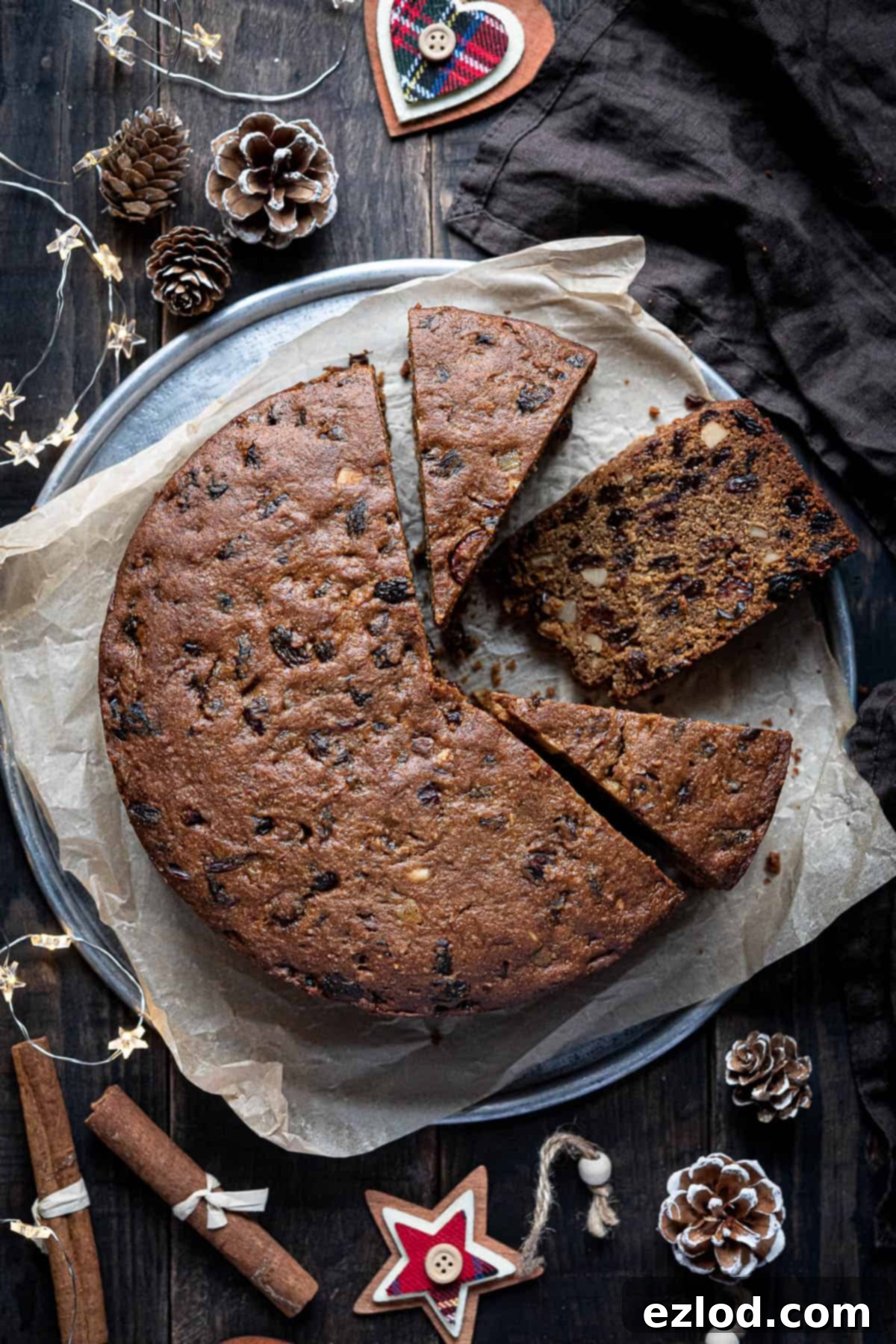
If you’ve given this exceptional recipe a try, I’d love to hear about your experience! Please rate it, leave a comment below, or share your creations on Instagram by tagging @domestic_gothess and using the hashtag #domesticgothess. Your feedback and photos truly make my day!
All images and content published on Domestic Gothess are protected by copyright. If you wish to share this recipe, please use the provided share buttons. Kindly refrain from screenshotting or directly posting the full recipe or its content. Instead, please include a direct link back to this original post for the recipe. Thank you for respecting my work!

Print
Gluten-Free Vegan Christmas Cake
Ingredients
- 125 g raisins
- 125 g sultanas
- 125 g currants
- 100 g dried cranberries
- 100 g mixed candied peel (or chopped dried apricots)
- 85 g glace cherries quartered
- 100 ml rum, whisky, brandy or sherry (plus extra for feeding)
- 125 g silken tofu
- 80 ml unsweetened non-dairy milk
- 1 Tablespoon vinegar
- 175 g vegan block butter (I use Naturli Vegan Block) softened
- 125 g dark brown soft/muscovado sugar
- 50 g light brown soft/muscovado sugar
- 30 g treacle
- finely grated zest of 1 orange
- finely grated zest of 1 lemon
- ¾ teaspoon xanthan gum
- ¾ teaspoon bicarbonate of soda (baking soda)
- 1 teaspoon mixed spice
- ½ teaspoon cinnamon
- ½ teaspoon nutmeg
- pinch salt
- 250 g oat flour OR a plain gluten-free flour blend (Doves Farm Freee)
- 90 g ground almonds (almond flour)
- 50 g gram flour
- 50 g chopped blanched almonds
Instructions
-
The day before you want to bake the cake (and up to a week in advance), mix together the dried fruits and the alcohol in a tub with a lid. Give them a stir every now and again to ensure that they are evenly coated.
-
The following day, preheat the oven to 150°C/130°C fan/300°F/gas mark 2. Grease a deep 20cm/8inch round cake tin and line it with a double layer of baking parchment.
-
Blend the silken tofu, milk and vinegar until smooth, either in a blender or in a jug with a stick blender (I use a stick blender).
-
In a large bowl, whisk together the vegan butter, dark and light brown sugars, treacle and orange and lemon zest until fluffy.
-
Whisk the xanthan gum, bicarbonate of soda, mixed spice, cinnamon, nutmeg and a pinch of salt into the butter mixture.
-
Add the gluten-free flour or oat flour, ground almonds, chickpea flour and the tofu mixture and mix to a smooth, thick batter.
-
Fold in the soaked fruit, along with any juices, and the chopped almonds.
-
Transfer the batter to the prepared tin and spread it level. Use the back of a wet spoon to smooth the top, re-wetting the spoon as needed.
-
Bake for about 2 hours 45 minutes until a skewer inserted into the centre comes out clean. You may need to loosely cover the top with tin foil towards the end of baking if the top starts to get too dark before the cake is cooked through.
-
Allow the cake to cool for 30 minutes then brush with 1 Tablespoon of your preferred alcohol. Leave to cool in the tin completely (about 8 hours).
-
Once the cake is completely cold, remove it from the tin and brush all over with a little alcohol.
-
Wrap the cake up in baking parchment then tin foil (it MUST be completely cold first), and store in an airtight container, feeding every week or two with alcohol, for up to three months.
Notes
- Refer to the detailed sections above for additional tips, in-depth ingredient explanations, and step-by-step photos to guide you through the process.
- For the very best results, it is highly recommended to follow this recipe precisely as written. Each ingredient and measurement contributes to the cake’s unique texture and flavor profile. Any alterations or substitutions are made at your own risk, as I cannot guarantee the outcome.
- Please note that US cup conversions have not been provided for this recipe. This is because the accuracy required for successful gluten-free and vegan baking often necessitates precise measurements, which scales offer. Using a kitchen scale for all ingredients is strongly advised.
- Feel free to customize your mix of dried fruits to suit your personal preference! As long as you maintain the same overall weight of 660g, you can experiment with various options. Delicious additions include chopped dried dates, figs, and apricots. For a more unique twist, consider incorporating dried cherries, blueberries, or even finely diced pineapple.
- To achieve perfectly clean and elegant slices, allow the cake to cool completely before cutting. Use a very sharp, serrated knife and employ a gentle sawing motion rather than pressing down firmly, which can cause the cake to crumble.
